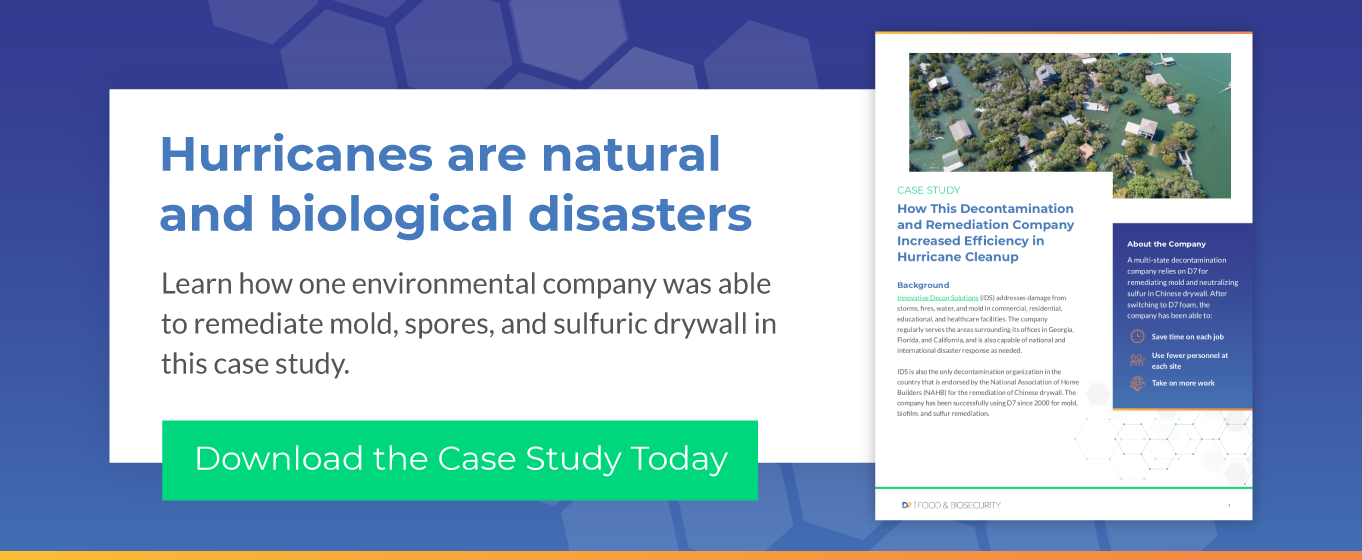
When disaster strikes, the short- and long-term effects can be devastating for businesses. In the short term, lost revenue and the inability to stay open present challenges for both owners and employees. In the long term, the investment required for rehabilitating damaged buildings can be overwhelming, even when insurance covers some costs. At the community level, the aftermath of a hurricane or other natural disaster can lead to disease and economic devastation.
Whether there has been a fire, flood, hurricane, or other disaster, getting back to business is often a top priority, but it can’t be at the expense of health and safety. Personal safety is the highest priority during the event and for disaster remediation.
5 Disaster Remediation Essentials
Although it’s best to leave the details to the professionals, following these five essential tips is a good starting point for disaster remediation.
1. Require Personal Protective Equipment (PPE)
If there is any possibility of the presence of harmful contaminants on-site, require all personnel to wear appropriate PPE. It’s also important to understand the potential risks of any decontaminating chemicals in use and to wear the recommended PPE for those. The necessary PPE will depend on the situation, but might include gloves, masks or respirators, hard hats, or full-body suits.
2. Understand Invisible Threats
Determining the potential risks after a disaster requires more than just a visual inspection—chemical and biological tests may also be necessary to fully understand the situation. Bacteria and other contaminants are not always visible to the naked eye, so test surfaces and materials to find out what’s there. Remember that mold can grow behind walls, under carpets and floors, and in the ceiling, so you might need to inspect and remediate these areas in order for it to be safe to return to the building.
3. Use Effective Products
Understand how remediation products work and be sure you are using the appropriate ones. For example, not all cleaners are effective against mold; some don’t neutralize harmful chemicals. Determine what specific contaminants you are dealing with and identify the products that are most effective against them.
Once you know what contaminant(s) you’re dealing with, compare multiple products for efficacy, ease of use, and safety.
4. Respect the Timeline
Immediately following a disaster, get approval from the appropriate authorities before resuming use of the building. Assess safety in terms of both the structure and potential contamination. Although it’s tempting to get back to business as quickly as possible, disaster remediation takes time. Before employees and customers can return to the premises, all risks need to be mitigated.
5. Hire Experts
Disaster remediation is not a task that should be undertaken on your own, even if it might seem more affordable or allow you to re-open your business more quickly. As noted above, you might not be aware of the hidden risks, and the safety of your employees and customers is paramount. Trained professionals will have the necessary experience, equipment, and products to identify and eliminate contaminants. Even if it seems like everything has returned to normal, it’s wise to bring in the professionals to ensure that it’s safe to return.
Decon7 Disaster Remediation Products
Disaster remediation experts rely on Decon7 products to mitigate a broad range of contaminants. D7 is effective* against biological contaminants such as bacteria, mold, and viruses. It is also able to safely neutralize toxic chemicals, making it a versatile choice for remediation professionals.
One example of D7 in action for multiple purposes was after Hurricane Katrina. Local residents were not only faced with mold in homes and businesses after extensive flooding, but many were also dealing with off-gassing hydrogen sulfide from imported Chinese drywall. Because D7 is effective against both mold and hydrogen sulfide, remediation teams could use a single product for multiple applications. Read the case study to learn the full story.
*see label for specific use instructions


